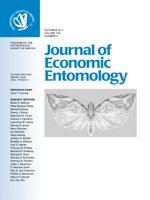The midge Dasineura mali Kieffer (Diptera: Cecidomyiidae) is an important pest of apple (Malus domestica Borkh.) and a potential fresh fruit contaminant, causing quarantine concerns. The phenological dynamics of D. mali and its egg parasitoid Platygaster demades Walker (Hymenoptera: Platygasteridae) were studied in the field in Palmerston North, New Zealand, for 2 yr. Both shoot infestation rate by D. mali and D. mali density per shoot sharply increased in the second generation, reaching ≈65% and 100–200 eggs, respectively. However, although the infestation rate in the third generation remained as high as in the second generation, the pest density per shoot significantly decreased to 40–60 eggs in the third generation. In the fourth generation, both infestation rate and pest density per shoot decreased to ≈30% and 10 eggs. Due to the simultaneous decline of the apple shoot number and D. mali density in the third and fourth D. mali generations, the absolute number of D. mali in the orchard also has declined proportionally during the same period. The parasitism and superparasitism rates significantly increased as the season progressed, from 45 to 55 and 37% in the first generation to 87 and 82% in the fourth generation, respectively. Our results suggest that P. demades contributes to the continuous decline of D. mali numbers in the field; it is a good searcher, particularly when its hosts become increasingly scarcer over the season, and it avoids overshooting the host population later in the season by increasing superparasitism. The frequency of P. demades aestivation increases from late spring to midsummer and then decreases during the late summer and early autumn. Although the emergence of P. demades was ≈2 to 3 wk behind that of D. mali in each generation, the increasing parasitism rates from the first to the fourth generations indicate that P. demades is synchronized with D. mali in the field.
BioOne.org will be down briefly for maintenance on 17 December 2024 between 18:00-22:00 Pacific Time US. We apologize for any inconvenience.
How to translate text using browser tools
1 October 2011
Phenological Dynamics of Dasineura mali (Diptera: Cecidomyiidae) and Its Parasitoid Platygaster demades (Hymenoptera: Platygasteridae) in Apple Orchards
Xiong Zhao He,
Qiao Wang
ACCESS THE FULL ARTICLE
It is not available for individual sale.
This article is only available to subscribers.
It is not available for individual sale.
It is not available for individual sale.

Journal of Economic Entomology
Vol. 104 • No. 5
October 2011
Vol. 104 • No. 5
October 2011
Dasineura mali
parasitism
phenology
Platygaster demades
synchronization




